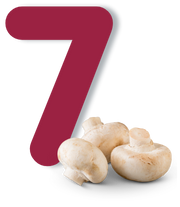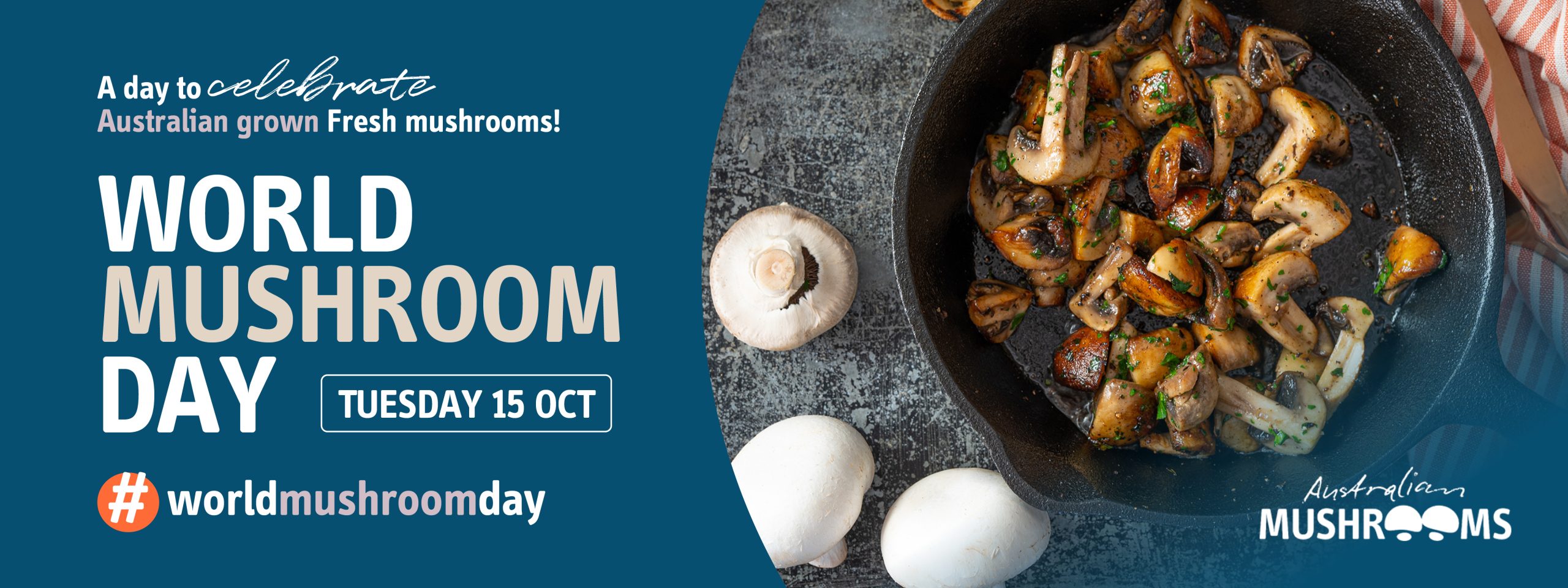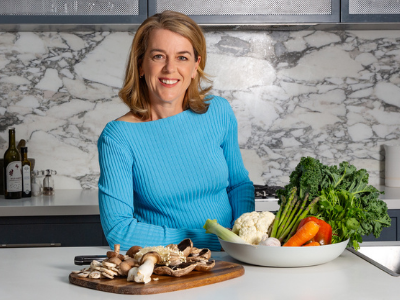
To help celebrate National Mushroom Day on Friday, October 15, we are excited to update you on new research and early-stage discoveries that could see us all inclined to eat more mushrooms for their ever-increasing range of health benefits.
In addition to being a super-food and nutritional all-rounder, it seems mushrooms could be a food recommended to help prevent vitamin D deficiency, heart disease, support the immune system and the gut.
Earlier this year, Nutrition Research Australia held an expert round-table, bringing together a group of leading Australian nutrition experts, food scientists, an Indigenous culture expert and a culinary nutrition expert, to discuss the science, history and future of mushrooms. We are excited to summarise the findings into seven key points, which is a taste of what is to come for Australian mushrooms. These findings provide more promising evidence as to why we should all strive to eat three mushrooms a day.

Mushrooms are an essential food, able to meet daily vitamin D requirements and support immunity.
Did you know that Australians spend $100 million dollars on vitamin D supplements every year – yet 1 in 4 of us are vitamin D deficient, with a further 2 in 5 of us in the lower range of normal? These are alarming statistics as vitamin D is an essential nutrient with a proven role in both optimal bone health and immune function, with low and deficient levels linked to increased rates of infection, notably respiratory infections and the prevalence of auto-immune diseases such as diabetes, multiple sclerosis and colitis.
But updated science, presented by the expert round table, demonstrated that mushrooms could be the whole-food solution Australia's problem of the publics low vitamin D levels. Within the walls of mushrooms is a vitamin D pre-cursor compound called ergosterol. It had been previously discovered that erogsterol was able to form vitamin D through exposure to sunlight. It was thought that mushrooms had to be left exposed sunlight (UV) for over an hour for the conversion to occur, but new research has since discovered, the exposure time only needs to be 15-minutes - which is a lot more achievable for us all, and a healthy habit to adpot. This means that if you leave your mushrooms out in the sunshine, let's say - while you unpack your groceries, the mushrooms will 'super charge' and be ready and able to meet daily vitamin D requirements.
A recent study also looked at the potency of a serve of sun-tanned mushrooms, which has now been compared to taking a daily low dose vitamin D supplement.
A food for which one serve is able to provide 100% of the recommended daily intake for vitamin D is very big news. It also means there is a whole food solution that saves us from exposing our skin to sunlight or taking extra vitamin D supplements.
The same study also looked at the shelf life of vitamin D once tanned. The re-assuring news is that measurements found that refrigeration of the mushrooms for up to 8 days was able to retain their high initial levels of Vitamin D. Also these levels can be protected when mushrooms by squeezing in a few drops of lemon juice or cooking the mushrooms with some juicy red tomatoes.
Dr Flavia Fayet-Moore, a member of the expert panel who has led many of the recent research projects into mushrooms, explained, “Tan your mushrooms and save your skin. Exposing just 1 Portobello mushroom to 15 minutes of sunlight can provide the same amount of vitamin D as a low dose vitamin D supplement (1000IU).”

Mushrooms support immunity and respiratory health.
In addition to being the new sunshine food, mushrooms were found to contain a number of other bioactive nutrients and antioxidants that able to help support and influence immune system responses.
In particular they are especially rich in key flavonoid and polyphenol type antioxidants known to help keep cells healthy, reduce inflammation and risks of chronic disease:- including heart disease, cancer and diabetes.
Mushrooms have also been found to contain an incredibly unique and potent source of a sulphur-containing amino acid ergothioneine. Ergothioneine is being touted as having many possible benefits in human health that include helping with cognitive function, inflammation and helping to protect the skin, the heart and the brain from the effects of aging.
But it is also in the research spotlight at the moment as casual observations noted that lower levels in the body could be associated with higher rates of COVID-19 hospital admissions and complications. While research is yet to establish a formal link between ergothioneine and COVID-19, it will be interesting to watch this space.
“In view of our understanding of poorer outcomes from COVID-19 in those with diet-related chronic disease, future dietary guidelines will need to consider not only chronic disease prevention but also how the associated inflammation may play out in our immune response” Dr Linda Tapsell.

Mushrooms as a food that lowers blood cholesterol.
While mushrooms are already known as a food for heart health, as it is fat-free, high in antioxidants and fibre, the panel explained some new exciting CSIRO research underway, looking into a specific role that mushrooms could have to help reduce blood levels of cholesterol.
Mushrooms have been found to contain very high levels of the soluble fibre beta-glucan. You may be familiar with beta-glucan if you eat barley or oats, as the beta-glucan in oats and barley has been
proven to help lower cholesterol, and these foods are now allowed to make claims on their label to that effect. But what is amazing is that mushrooms have double the amount of beta-glucan as an equivalent serving of oats and could also be used as a food also able to help reduce the need for prescribed lipid lowering medications.
But before we can make this claim, we need to ensure the beta-glucan in mushrooms acts in the same way as it does in oats and barley. Which is why the CSIRO is undertaking some human research trials in consultation with our food authority FSANZ.
Working in consultation with Food Standards Australia and New Zealand (FSANZ) to help ensure that the evidence uncovered allows for an approved health or what is known as a functional food claim. This means that it can be explained on mushroom bags and promotions that it is a food specifically able to help lower cholesterol. It is hoped the results of these important studies will be available in early 2026.

Mushrooms support gut health.
The panel were also intrigued with the potential role of another interesting pre-biotic ingredient in mushrooms that could help improve gut function and health.
A pre-biotic rich food helps to feed and increase the good types of bacteria in the gut, which is then what helps to improve gut function. The pre-biotic in mushrooms is known as chitin. Chitin is also the woody structure in mushrooms that contributes to texture, mouthfeel, and taste. It is also the likely
driver behind trial results that showed a significant improvement in gut function when mushrooms replaced meat in the diet. These improvements included an increase in stool weights, less strain, odour and increased numbers in beneficial types of good bacterias known as bacteriodetes and reduced numbers of the harmful types of bacterias known as firmicute types.
Chitin is a pre-biotic rich nutrient and fibrous structure in the cell wall of mushrooms. It contributes to their firm texture, mouthfeel and taste.
Jim Fuller, chef, turned mycologist recommends boiling your mushrooms to help break down the fibrous structures in the cell wall of mushrooms. The result is a nutritious, lower salt but still a flavoursome way to provide the savoury ‘umami’ taste that can help drive the palatability of other foods.
Jim’s top tip is to boil your mushrooms by:
Pouring a little water into a hot pan and bring to a boil. Throw in your mushrooms, and then reduce the water before you then sautee.

Mushrooms could reduce cancer risk.
Cancer is another illness that affects the lives of too many Australians. While the expert panel outlined that more studies are needed before we can claim mushrooms can help to lower cancer risk, some interesting preliminary trials have shown that including a regular serving of mushrooms could help.
One study found that eating a typical serving of white buttons could reduce women's chances of being hit with ovarian cancer by around 1/3. In men, another trial found that a regular intake of mushrooms in the diet helped to improve prostate treatment outcomes. The study reported that eating between 40-140g of mushrooms lowered the PSA measure in around 1/3 of cases. PSA is an antigen tracked in men with prostate cancer, and a lower number is better.

Mushrooms and their place in the updated Australian Dietary Guidelines.
Another big question discussed by the expert panel is where mushrooms should be put in the next edition of the Australian Dietary Guidelines (ADG). The current edition has been in circulation since 2013, and they are currently being reviewed and will be updated. In the past, mushrooms had been mis-classified as a vegetable, so they appeared alongside vegetables such as corn, peas and carrots - giving consumers the misconception that mushrooms are a vegetable.
As their unique and all-rounder nutrition profile comes to light, it seems that they are a food that could add value across many food groups including vegetables, the meat and the grain group.
It is also important to recognise that mushrooms are not actually a plant or animal food, but a fungi. They also offer a wider range of nutrient and dietary need options, than what is suggested in the current guidelines that lists mushrooms as a vegetable and recommends it as just one option that can be used to meet the 5-a-day.
Nutrition researcher and Dietitian Glenn Cardwell has been stating for many years, "Mushrooms are not a plant food, nor are they an animal food, but they belong to an entire kingdom of their own".

Uncovering the history of Australian native mushrooms.
Another interest area explored by the panel included the role mushroom may have played in the lives of our First Nations People. As while we know mushrooms, have been used as a food and medicine in Asian and many other older populations. We really do not know much about how our First Nations People used and cultivated mushrooms.
Leading expert on indigenous culture, Arpad Kalotas, explained that although we do know that there
is a wide range of Australian native fungi that were valued and consumed by the First Nations people, little is known about how they were used and consumed. Therefore, the panel recommended that further work be undertaken with Indigenous communities and researchers to learn more about the role Australian native fungi had in traditional diets and options to extrapolate their uses into regular diets.
Dr Flavia Fayet-Moore from Nutrition Research Australia sums it up, by empasising that based on the emerging evidence, we should all be striving to consume at least 3 cup mushrooms (which equates to one cup of chopped raw mushrooms) every day.
So, let me ask you... have you had your three mushrooms today?
Note: the information in this article is meant as general information only. For specific, personal advice on any medical condition, please see your doctor.
AMGA Dietitian - Jane Freeman
Jane is an internationally regarded and experienced dietitian and nutritionist, is an IOC (International Olympic Committee) qualified sports nutritionist, Leiths qualified cook and an award-winning author.
As a practicing dietitian and director for CANutriton, a cancer specialist nutrition practice in Sydney, Jane is big mushroom lover and passionate about delivering practical nutrition advice that is easy to understand and adopt.
References:
Health Professionals can find the expert round table white paper on our website.
Mushrooms and vitamin D, immunity, bone, gut and respiratory health
G. Cardwell, J.F. Bornman, A.P. James, L.J. Black
A review of mushrooms as a potential source of dietary vitamin D
Nutrients, 10 (2018), p. 1498
I. Erjavec, J. Brkljacic, S. Vukicevic, et al.
Mushroom extracts decrease bone Resorption and improve bone formation
Int J Med Mushrooms, 18 (2016), pp. 559-569
C.B. Stephensen, M. Zerofsky, D.J. Burnett, et al.
Ergocalciferol from mushrooms or supplements consumed with a standard meal increases 25-hydroxyergocalciferol but decreases 25-hydroxycholecalciferol in the serum of healthy adults
J Nutr, 142 (2012), pp. 1246-1252
R.H. Keegan, Z. Lu, J.M. Bogusz, et al.
Photobiology of vitamin D in mushrooms and its bioavailability in humans
Dermatoendocrinol, 5 (2013), pp. 165-176
P. Urbain, F. Singler, G. Ihorst, et al.
Bioavailability of vitamin D2 from UVB-irradiated button mushrooms in healthy adults deficient in serum 25-hydroxyvitamin D: a randomized controlled trial
Eur J Clin Nutr, 65 (2011), pp. 965-971
R.R. Simon, K.M. Phillips, R.L. Horst, I.C. Munro
Vitamin D mushrooms: comparison of the composition of button mushrooms (Agaricus bisporus) treated postharvest with UVB light or sunlight
J Agric Food Chem, 59 (2011), pp. 8724-
K.M. Phillips, D.M. Ruggio, R.L. Horst, et al.
Vitamin D and sterol composition of 10 types of mushrooms from retail suppliers in the United States
J Agric Food Chem, 59 (2011), pp. 7841-7853
N.Charoenngam, M.F. Holick
Immunologic effects of vitamin D on human health and disease
Nutrients 12(7), (2020) pp.12:2097
A.J. Weigand-Heller, P.M. Kris-Etherton, R.B. Beelman
The bioavailability of ergothioneine from mushrooms (Agaricus bisporus) and the acute effects on antioxidant capacity and biomarkers of inflammation
Prev Med, 54 (Suppl) (2012), pp. S75-S78
M.D. Kalaras, J.P. Richie, A. Calcagnotto, R.B. Beelman
Mushrooms: a rich source of the antioxidants ergothioneine and glutathione
Food Chem, 233 (2017), pp. 429-433
D. Wu, M. Pae, Z. Ren, et al.
Dietary supplementation with white button mushroom enhances natural killer cell activity in C57BL/6 mice
J Nutr, 137 (2007), pp. 1472-1477
S. Yoshida, H. Shime, K. Funami, et al.
The anti-oxidant ergothioneine augments the immunomodulatory function of TLR agonists by direct action on macrophages
PloS One, 12 (2017), Article e0169360
B. Halliwell, I.K. Cheah, R.M.Y. Tang
Ergothioneine - a diet-derived antioxidant with therapeutic potential
FEBS Lett, 592 (2018), pp. 3357-3366
S. Chen, T. Yong, Y. Zhang, et al.
Anti-tumor and anti-angiogenic ergosterols from Ganoderma lucidum
Front Chem, 5 (2017), p. 85
M.Y. Um, J.H. Park, S.Y. Gwon, et al.
Agaricus bisporus attenuates dextran sulfate sodium-induced colitis
J Med Food, 17 (2014), pp. 1383-1385
J. Hess, Q. Wang, T. Gould, J. Slavin
Impact of Agaricus bisporus mushroom consumption on gut health markers in healthy adults
Nutrients, 10 (2018), p. 1402
J. Nishihira, M. Nishimura, A. Tanaka, et al.
Effects of 4-week continuous ingestion of champignon extract on halitosis and body and fecal odor
J Tradit Complement Med, 7 (2017), pp. 110-116
S.C. Jeong, S.R. Koyyalamudi, G. Pang
Dietary intake of Agaricus bisporus white button mushroom accelerates salivary immunoglobulin a secretion in healthy volunteers
Nutrition, 28 (2012), pp. 527-531
M. Akyüz, A.N. O'nganer, P. Erecevit, S. Kirbag
Flavonoid contents and 2,2-diphenyl-1-picrylhydrazyl radical scavenging activity of some edible mushrooms from Turkey: A. Bisporus and Pleurotus Spp
Curr Top Nutraceutical Res, 10 (2012), pp. 133-136
A. Ganguli, M. Ghosh, N. Singh
Antioxidant activities and total phenolics of pickles produced from the edible mushroom, Agaricus bisporous
J Culinary Sci Tech, 5 (2006), pp. 131-
L.C. Buruleanu, C. Radulescu, A.A. Georgescu, et al.
Statistical characterization of the phytochemical characteristics of edible mushroom extracts
Anal Lett, 51 (2018), pp. 1039-1059
Mushrooms and gut health
A.K. Singh, D. Dutta
Extraction of chitin-Glucan complex from Agaricus bisporus: characterization and antibacterial activity
J Polym Mater, 34 (2017), pp. 1-9
P. Manzi, A. Aguzzi, L. Pizzoferrato
Nutritional value of mushrooms widely consumed in Italy
Food Chem, 73 (2001), pp. 321-325
Mushrooms as a food that lowers blood cholesterol
S. Zhao, S. Zhang, W. Zhang, et al.
First demonstration of protective effects of purified mushroom polysaccharide-peptides against fatty liver injury and the mechanisms involved
Sci Reports, 9 (2019), p. 13725
cv
G. Henriques, C. Helm, A. Busato, M. Simeone
Lipid profile and glycemic response of rats fed on a semi-purified diet supplemented with Agaricus brasiliensis mushroom
Acta Sci Anim Sci, 38 (2016), pp. 71-79
O. Rop, J. Mlcek, T. Jurikova
Beta-glucans in higher fungi and their health effects
Nutr Rev, 67 (2009), pp. 624-631
J.J. Volman, R.P. Mensink, L.J. van Griensven, J. Plat
Effects of alpha-glucans from Agaricus bisporus on ex vivo cytokine production by LPS and PHA-stimulated PBMCs; a placebo-controlled study in slightly hypercholesterolemic subjects
Eur J Clin Nutr, 64 (2010), pp. 720-726
A.A. Kahn, A. Gani, F.A. Masoodi, et al.
Structural, rheological, antioxidant, and functional properties of β-glucan extracted from edible mushrooms Agaricus bisporus, Pleurotus ostreatus and Coprinus attrimentarius
Bioact Carbohydr Diet Fibre, 11 (2017), pp. 67-74
M. Palanisamy, L. Aldars-Garcia, A. Gil-Ramirez, et al.
Pressurized water extraction of beta-glucan enriched fractions with bile acids-binding capacities obtained from edible mushrooms
Biotechnol Prog, 30 (2014), pp. 391-400
W.I.A. Abd-alwahab, F.K.Y. Al-dulaimi, A.T. Abdulqader
Effect of mushroom cooked in olive oil on some physiological and biochemical parameters of human
Eurasia J Biosci, 12 (2018), pp. 393-397
Mushrooms could reduce cancer risk
A.G. Guggenheim, K.M. Wright, H.L. Zwickey
Immune modulation from five major mushrooms: application to integrative oncology
Integr Med (Encinitas), 13 (2014), pp. 32-44
X. Li, Q. Wu, Y. Xie, et al.
Ergosterol purified from medicinal mushroom Amauroderma rude inhibits cancer growth in vitro and in vivo by up-regulating multiple tumor suppressors
Oncotarget, 6 (2015), pp. 17832-17846
A.H. Lee, M. Pasalich, D. Su, et al.
Mushroom intake and risk of epithelial ovarian cancer in southern Chinese women
Int J Gynecol Cancer, 23 (2013), pp. 1400-1405
P. Twardowski, N. Kanaya, P. Frankel, et al.
A phase I trial of mushroom powder in patients with biochemically recurrent prostate cancer: roles of cytokines and myeloid-derived suppressor cells for Agaricus bisporus-induced prostate-specific antigen responses
Cancer, 121 (2015), pp. 2942-2950
Join our Mushroom Lovers Club!
Receive delicious Mushroom recipies and much more.












